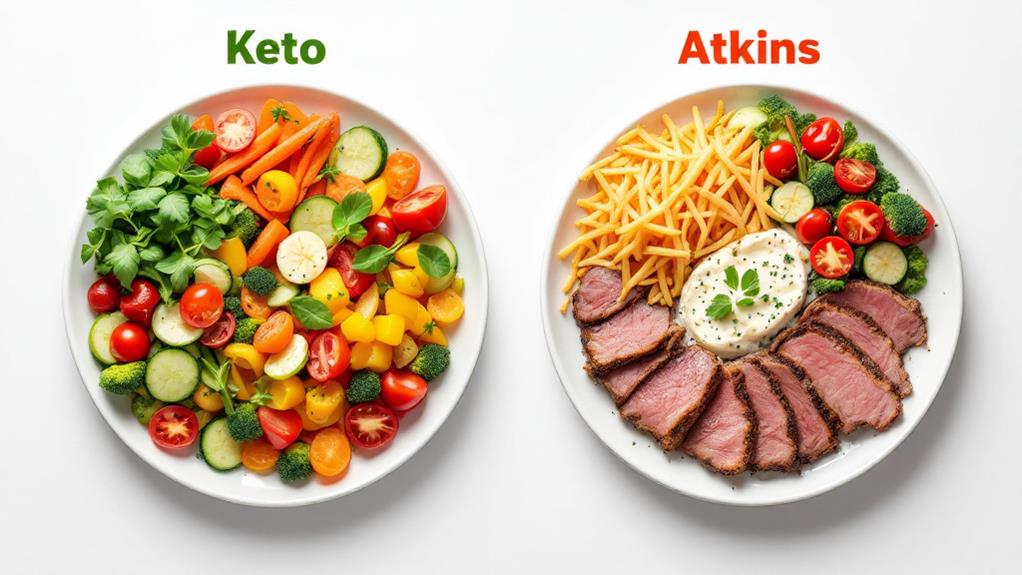Keto vs. Atkins: Understanding the Difference Between These Popular Diets

When comparing Keto and Atkins, you'll notice both focus on reducing carbohydrates to aid weight loss and improve metabolic health. The Keto diet keeps your carbs very low, around 5-10% of daily calories, to maintain ketosis, while Atkins starts with a low-carb phase and gradually reintroduces them. Keto emphasizes high fat intake, whereas Atkins allows more protein and varied food options over time. Both can lead to nutrient deficiencies, so supplements might be needed. Keto's strict nature poses adherence challenges, unlike the phased flexibility of Atkins. Uncover the nuances that set these diets apart further.
Overview of Keto and Atkins
Exploring the differences between the Keto and Atkins diets can help you understand their unique approaches to weight loss through carbohydrate restriction. Both are popular low-carb diets, but they have distinct methods. The Keto diet is strict about carbohydrate intake, limiting it to about 5-10% of your daily calories, roughly 20-50 grams of carbs per day. This low level is crucial to maintain ketosis, where your body uses fat for fuel. In contrast, the Atkins diet consists of four phases, beginning with 20-25 grams of net carbs in Phase 1 and increasing to 80-100 grams as you reach Phase 4, which is more about maintenance.
With Keto, you focus heavily on dietary fat, making up 70-75% of your intake, which supports continuous ketosis. Atkins, however, allows for gradual carbohydrate reintroduction, providing more flexibility. Both diets aim to improve metabolic health and promote weight loss, but the approach and structure differ. While Keto demands consistent low-carb intake, Atkins offers a phased approach that might appeal if you want more variety. Understanding these differences helps you choose the diet that aligns best with your lifestyle and weight loss goals.
Key Similarities
While the Keto and Atkins diets have distinct approaches, they share several key similarities. At their core, both are low-carb diets designed to help you achieve your weight loss goals through considerable carbohydrate restriction. You'll find that these diets often limit your carbohydrate intake to around 20-50 grams per day. This reduction in carbs encourages your body to enter a state of ketosis, where fat becomes the primary energy source instead of carbohydrates, aiding in fat loss.
Both diets emphasize a high-fat diet, which means you'll focus on consuming foods rich in healthy fats while limiting sugars and refined carbohydrates. This approach allows you to prioritize macronutrient ratios over counting calories, making the diets sustainable for many.
Here are some key similarities between the two diets:
- Low-carb focus: Both diets restrict carbohydrates considerably to promote weight loss.
- High-fat consumption: They encourage eating high-fat foods, using fat as the main energy source.
- Ketosis: Both diets can induce a state of ketosis, helping burn fat for fuel.
- Health benefits: They may improve blood sugar management and cholesterol levels, supporting short-term weight loss.
Main Differences

One major difference between the Keto and Atkins diets is how they manage carbohydrate intake. The Keto diet strictly limits carbs to 5-10% of your daily calories, usually capping at 20-50 grams. This helps maintain ketosis, a metabolic state where your body burns fat for energy. In contrast, the Atkins diet starts with 20-25 grams of carbs in Phase 1 but gradually increases as you progress through its four phases, allowing for more flexibility over time.
The Keto diet emphasizes high fat (70-75%) and low protein (20-25%) intake to sustain ketosis. Meanwhile, the Atkins diet permits higher protein consumption without strict limits, focusing more on reducing carbs for weight loss. This difference in protein consumption can influence your food choices and general approach to each diet.
Moreover, the Keto diet's strict restrictions on food variety could lead to nutrient deficiencies, as it limits what you can eat. The Atkins diet, however, allows for a broader range of food choices, especially in later phases, reducing that risk. While both aim for weight loss, the Atkins diet's phased approach might suit those preferring gradual changes, while Keto requires consistent adherence to maintain its metabolic state.
Health Considerations
In relation to health considerations, diving into the Keto or Atkins diet requires careful thought. Both are restrictive diets that can lead to nutrient deficiencies, so you might need supplements to maintain your health. Initial weight loss is often just water weight, and many people regain it once they stop the diet. It's vital to consult a healthcare provider, especially if you have health conditions like diabetes, heart disease, or kidney disease, as these diets can pose significant risks.
- The Keto diet, with its high saturated fat intake, could increase your risk of heart disease and kidney stones.
- Monitoring your health markers is important to guarantee nutritional adequacy and catch any adverse effects early.
- High dropout rates, up to 84% for ketogenic diets, suggest that long-term adherence is challenging.
- Both diets can require supplements to address potential nutrient deficiencies due to their restrictive nature.
Expert Recommendations

Before starting the Keto or Atkins diet, it's important to consult with a healthcare professional or a registered dietitian. This guarantees the diet aligns with your weight and health needs, preventing potential health risks. A registered dietitian nutritionist can help you create personalized dietary plans that fit your lifestyle and preferences, increasing your chances of long-term success.
Both diets require careful carb intake management, but they have different approaches. The Keto diet aims to induce ketosis, which can be quite restrictive, making nutrient supplementation critical to avoid deficiencies. On the other hand, the Atkins diet offers more flexibility with its phased approach, allowing you to gradually adjust your carb intake.
Monitoring health markers like blood glucose levels and lipid profiles is fundamental during the implementation of these diets. This monitoring helps you and your healthcare team identify any adverse effects early, guaranteeing your diet supports your comprehensive health goals.




